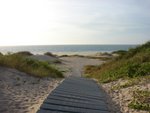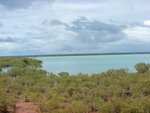 This is the mythically beautiful land that we now call home, albeit we’re in the relatively crowded town of Broome on the extreme edge of the Kimberley, on a flat spit of land stretching out into the Indian Ocean, a peninsular reaching west towards Africa, recognising the relationship between the idiosyncratic Boab and Boabab trees of the two ancient lands. Legends in Black Africa and Aboriginal Australia both speak of a tree being planted upside down.
This is the mythically beautiful land that we now call home, albeit we’re in the relatively crowded town of Broome on the extreme edge of the Kimberley, on a flat spit of land stretching out into the Indian Ocean, a peninsular reaching west towards Africa, recognising the relationship between the idiosyncratic Boab and Boabab trees of the two ancient lands. Legends in Black Africa and Aboriginal Australia both speak of a tree being planted upside down.  This is the land we had to see, Buccaneer archipelago shatters into thousands of uninhabited islands, many hidden by the rising 10 metre tides, some have remnants of dwellings, hinting to a time when people lived purely off the land and sea, whose descendants now walk the streets of towns, looking at the wares for sale, listening to the spirit of Jack Daniels more than the spirit of the land. Some island have remnants of more recent visitors, footprints and tackle, from the adventurous big game fisherman who stopped to camp between hunting these waters for that elusive sailfish. Occasionally these waters give up a sailfish, the biggest ever landed was landed here.
This is the land we had to see, Buccaneer archipelago shatters into thousands of uninhabited islands, many hidden by the rising 10 metre tides, some have remnants of dwellings, hinting to a time when people lived purely off the land and sea, whose descendants now walk the streets of towns, looking at the wares for sale, listening to the spirit of Jack Daniels more than the spirit of the land. Some island have remnants of more recent visitors, footprints and tackle, from the adventurous big game fisherman who stopped to camp between hunting these waters for that elusive sailfish. Occasionally these waters give up a sailfish, the biggest ever landed was landed here. This is picture perfect paradise, white beaches and sunshine, where you can discover another secluded beach every day, where the sun is statistically more carcinogenic than any other country, where the water harbours sharks and even several species of stinging jellyfish which swarm and envenomate their prey with deadly cardio toxins. The most notorious of which is the Irukanji, which is practically invisible in water but deadly to humans. The land, rivers, estuaries and sea is home the Salt Water Crocodile, the planets biggest reptile. Some the planets deadliest snakes also live here. Perhaps it’s obvious why this is the second most sparsely populated place on Earth.
Perhaps it’s also obvious why we went to look by means of a light plane, well out of striking range of the Western Brown Snake, where our only worry was the weather, and a third cyclone in as many weeks was pretty unlikely.
Come to the Kimberley and Good Luck




